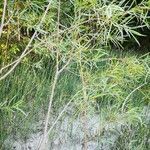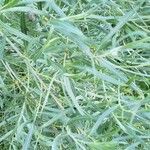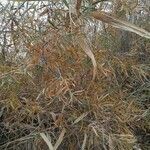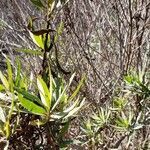Shrubs or trees, 0.5-5(-17) m. Stems: branches gray-brown, red-brown, or yellow-brown, villous, or tomentose to glabrescent; branchlets yellowish, yellow-brown, or red-brown, pubescent or puberulent, tomentose, short-or long-silky villous. Leaves: stipules absent or rudimentary on early ones, foliaceous or rudimentary on late ones; petiole 1-5(-10) mm, pubescent or puberulent, villous, or short-silky adaxially; largest medial blade (sometimes hypostomatous), linear or lorate, (glands marginal), 30-136-143 × 2-14 mm, 6.5-28(-37.5) times as long as wide, base cuneate, margins slightly revolute, entire or remotely spinulose-serrulate, apex acuminate or acute, abaxial surface glaucous (sometimes obscured by hairs), densely long-silky, villous or pilose to glabrescent, hairs appressed or spreading, straight or wavy, adaxial slightly glossy, sparsely or densely long-silky to glabrescent; proximal blade margins entire; juvenile blade yellowish green, densely long-silky-villous abaxially. Catkins: staminate 7-54 × 2-10 mm, flowering branchlet 1.5-56 mm; pistillate loosely to densely flowered, slender or stout, 14.5-70 × 3-12 mm, flowering branchlet 2-55 mm; floral bract 1.2-2.6 mm, apex acute, convex, or rounded, entire or erose, hairs wavy, straight, or crinkled, abaxially hairy throughout or proximally, or glabrate. Staminate flowers: abaxial and adaxial nectaries present and distinct; filaments hairy on proximal 1/2; anthers (sometimes reddish turning yellow). Pistillate flowers: adaxial nectary oblong, ovate, or flask-shaped, relative adaxial nectary/stipe length variable even within same catkin; stipe 0-0.9 mm; ovary obclavate or pyriform, glabrous, pilose, or villous, or sometimes beak hairy, beak bulged below or abruptly tapering to styles; ovules 12-30 per ovary; styles (sometimes distinct), 0-0.5 mm; stigmas flat, abaxially non-papillate with rounded tip, or 2 plump lobes, 0.1-0.5 mm. Capsules 4-8 mm. 2n = 38.
More
Many-stemmed colonial shrub 1.5–3(–5) m, the slender, brown to reddish-brown, leafy twigs sericeous at least when young, often soon glabrous; stipules minute and caducous (rarely to 3 mm) or obsolete; lvs linear or broadly linear to linear-oblanceolate, 5–14 cm × 5–12(–18) mm, acute or acuminate at both ends, subsessile, remotely and irregularly spinulose-denticulate, green on both sides but paler beneath, often sericeous when young, later glabrous (or the new lvs produced after insect-attack more densely and permanentlSy sericeous); catkins with the lvs, 1–3 together on very short lateral branches from axillary buds of the previous year, and often again in midsummer, terminating leafy lateral branches 3–10 cm; scales pale, yellowish, soon deciduous; stamens 2; pistillate catkins lax, 2–6(–8) cm; frs narrowly lanceolate, 5–8 mm; pedicels 0.5–1.5 mm; style virtually obsolete; 2n=38. Common on sandbars, mudbars, and moist alluvial soil; widespread in the U.S., s. Can., and n. Mex. Plants from e. of the Rocky Mts., as here described, constitute the subsp. interior (Rowlee) Cronquist (S. interior; S. longifolia Muhl., not Lam.), which has 2 vars. All or nearly all our plants belong to the var. angustissima (Andersson) Reveal & C. R. Broome, which has the ovaries hairy at least when young, although the frs are often glabrate. The more n. or nw. var. pedicellata (Andersson) Cronquist, with the ovaries and frs glabrous from the first, may be sought along the w. margin of our range.
A spreading shrub. It grows 3 m tall. The stems are long and smooth.





